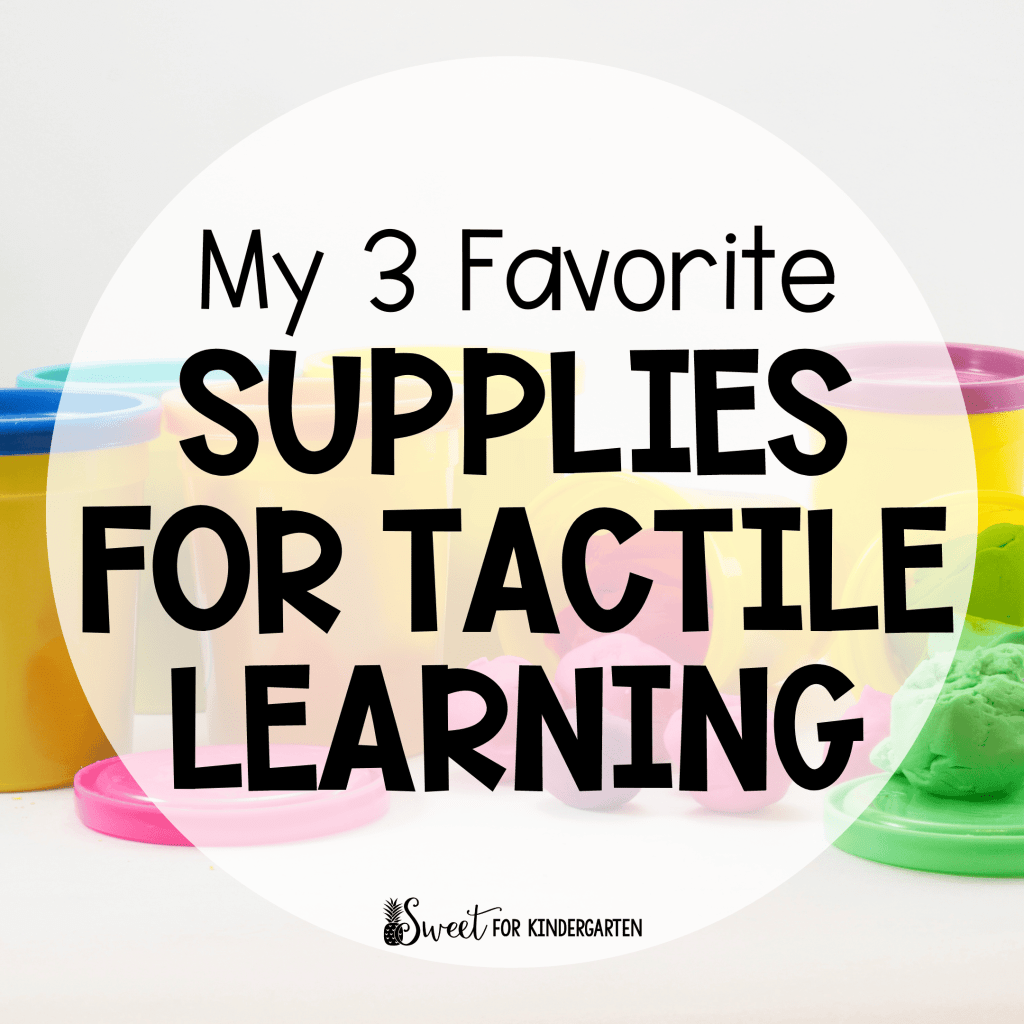When I was little, I remember struggling with how to tie my shoes. I watched my mom show me 1000 times, but I just could not get it. It wasn't until she helped me do it by placing her hands over mine while showing me, that I was able to learn independently. Many kids need to learn by DOING. You can tell them and model something a bunch of times, but sometimes it takes them doing it or using their hands to actually learn. Today, I am going to share all about my 3 favorite supplies for tactile learning and how to incorporate them into your multi-sensory phonics center activities.

This post contains Amazon affiliate links. I earn a small commission each time someone makes a purchase through one of my affiliate links. This helps support my blog, Sweet for Kindergarten. I only recommend products that I love. All ideas shared are my own.
What is tactile learning?
Most kids are kinesthetic or tactile learners, meaning they learn by doing or using their hands. Specifically, tactile learning is hands-on learning, using manipulatives and other sensory materials to learn. As early childhood educators, we should use tactile learning a lot in our classrooms. It is so simple to make these tactile activities fun and engaging.
Why is tactile learning so important?
Right now, with technology present more than ever, there is a lack of tactile activities. Students are using iPads or computers and not doing much with their hands. Their hand muscles are still developing in Kindergarten, meaning their little hands need a lot of work every day. Weak hand muscles and poor hand control can lead to poor handwriting, frustration when writing, and hand fatigue. I’ve seen it before where students who come into Kindergarten that did not have enough fine motor practice really struggle when learning how to write, creating frustrations as the year progresses.
Including tactile activities in your phonics lesson or during your ELA center rotation doesn't have to be hard! If you have these 3 supplies, you can practice any phonics skill in a hands-on way.
Using play dough

Play dough is my number one go-to supply for tactile learning. It is so versatile to use for any subject, but I am going to help you think of a few phonics ideas. The easiest way to use it is to roll it out like a snake to form letters. I suggest buying a big pack of play dough on Amazon at the beginning of the year, asking for parent donations, or you can even make your own!
Here are some ideas for phonics practice using play dough:
- Identifying the beginning sound of a word: Say a sound and have students roll out the letter
- Spelling CVC words: Say the CVC word (or show a picture) and have students roll out the letters to spell it
- Counting syllables: Have students roll 4 balls of play dough. Say a word and have students smash one ball for each syllable

You can find these Phonics Play Dough Mats practicing these skills and more here.
Letter Magnets

The second tactile supply I recommend is letter magnets. You can use letter magnets just the same as you would use play dough for isolating sounds or spelling words. Letter magnets are also very helpful when learning how to spell. Students are able to move the letters around more easily using magnets. If they were writing and made a mistake, they would have to erase it rather than just move the letter around.

You can find these Phonics Spelling Activity Mats practicing these skills and more here.
Common Household Items
Rather than buying something new, you can use something you already have! You can find so many things in your own household, at a grocery store, or in your classroom already. Plus, when you break out something new, you know your students will be very engaged in the exciting, brand-new activity.

Here is a list of a few ideas that you can add to your sensory supply box:
- Beans, cereal, or pasta wheels: Students can push the beans forward when practicing oral blending or segmenting.
- Rice or sand: Put into a small bin and pair with picture cards for students to isolate sounds or spell words using their fingers in the rice or sand.
- Legos or Blocks: Write letters with dry-erase markers, and break apart words by phoneme or syllables.
- Shaving Cream: Use to spell words or write letters.
Which tactile supply do you want to try during your phonics lesson or center activity?
Resources Mentioned in this Post
-
Phonics Word Building and Spelling Activity Cards | Ending Consonant Blends$3.00
-
Phonics Word Building and Spelling Activity Cards | Beginning Consonant Blends$3.00
-
Play Dough Phonics and Phonemic Awareness Mats MEGA Bundle | Fine Motor Activity$10.00
-
CVC Words Spelling Mats | Phonics Activity Bundle$7.00





